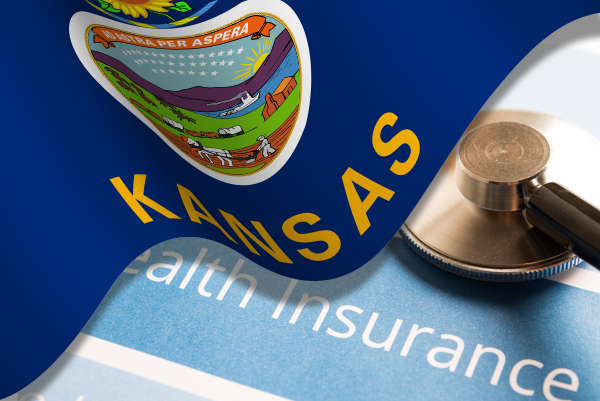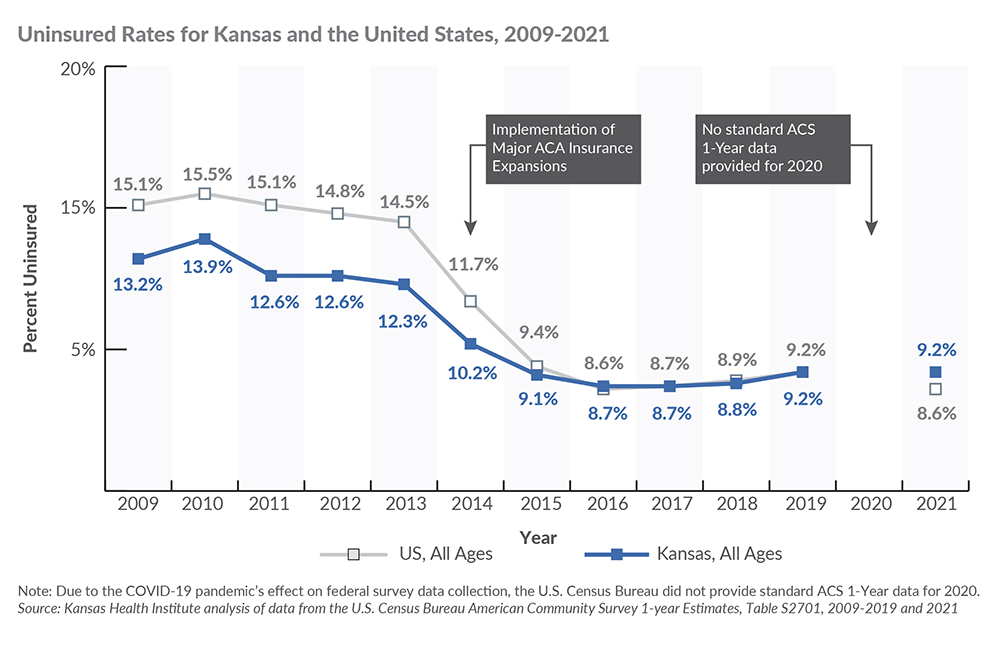“For many years Kansans could know that our rate of health insurance coverage was better than the country as a whole. After the ACA took effect, we saw the national rate catch up to Kansas, and new data show us that in 2021, for the first time, the Kansas uninsured rate was higher than the U.S. overall. That’s a milestone we didn’t want to reach,” said Kari Bruffett, President and CEO of the Kansas Health Institute. “While there is good news in the data too — insurance coverage in Kansas overall held steady between 2019 and 2021, despite the COVID-19 pandemic — there are also continuing disparities in health insurance for Black and Hispanic Kansans.”
Additional points from the 2021 ACS data release:
- Adults age 19-64 are more likely to be uninsured in Kansas compared to their peers around the country (13.5 percent in Kansas compared to 12.2 percent in the U.S.).
- After major ACA insurance expansions were enacted in 2014 — including Medicaid expansion in many states, but not Kansas — Kansas residents who identify as Hispanic or Black were more likely to be uninsured in Kansas than the U.S.
-
- 20.3 percent of Kansas residents who identify as Hispanic were uninsured — a decrease from the 23.3 percent who were uninsured in 2019, but still higher than the 17.7 percent of Hispanic residents uninsured across the country.
- 14.1 percent of Kansas residents who identify as Black or African American were uninsured compared to 9.6 percent across the country.
- Kansans living below 138 percent of the poverty line were more likely to be uninsured than those with similar circumstances in other states (18.5 percent in Kansas compared to 14.9 percent for the U.S.).
“The higher uninsured rate in Kansas compared to the U.S. signals that some Kansans face barriers to attaining comprehensive affordable health insurance that residents of other states do not,” said Phillip Steiner, M.A., Senior Analyst at the Kansas Health Institute. “There may be contributing factors other than policy differences like Medicaid expansion. KHI is looking forward to further investigating these data to better understand what might be driving the disparity.”
The U.S. Census Bureau will release additional data with state-level detail on October 20, 2022. Check our website frequently for additional analysis and information on the annual insurance update.
NOTE: This analysis uses data from the 2009−2019 and 2021 American Community Survey (ACS) 1-year Estimates released today. Earlier this week, the U.S. Census Bureau also released data from the 2021 Current Population Survey (CPS). Estimates of insurance coverage may differ slightly between the ACS and CPS. The ACS estimates are better for analyzing state-level data and therefore were used in this analysis.
Access additional publications in the Documents & Downloads section.
Related news reports:
- Big Pandemic Spending at Kansas Hospitals Could Make Your Insurance Even More Expensive — Sept. 28, 2022, KMUW Wichita and Sept. 24, 2022, KCUR Kansas City (Rose Conlon)
- More Americans Getting Health Insurance – But Not Kansans — Sept. 24, 2022 , Derby Informer (Rose Conlon)
- For the First Time in Decades the Uninsured Rate in Kansas is Higher Than the U.S. Average — Sept. 22, 2022, KCUR Kansas City (Up to Date podcast with Steve Kraske)
- Kansas Uninsured Rate Now Higher Than National Average — Sept. 19, 2022, Kansas Reflector (Rachel Mipro)
- More Americans Got Health Insurance During the Pandemic, But Not in Kansas — Sept. 16, 2022 , KMUW Wichita (Rose Conlon)

